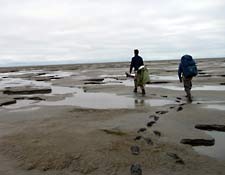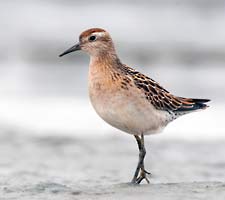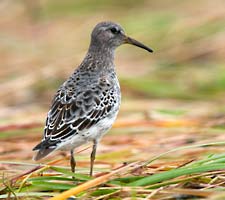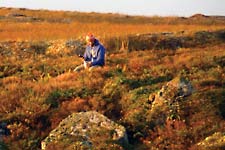Next Stop, New Zealand: Godwit Migration
By Charles Eldermire
October 15, 2010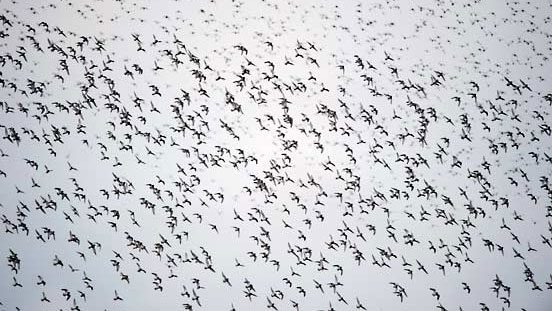
Thousands of godwits fly thousands of miles, but never quite come into focus
After nearly a week of travel, all that separated us from our quarry was a mile of soft, squelchy mud. Clouds of shorebirds probed at it, fluttered over it—but our hip waders just sank in under the weight of our cameras.
We were a three-person film team from the Cornell Lab, and we were here, on the shores of the Bering Sea, to videotape Bar-tailed Godwits preparing for a marathon.
In a week or two, these birds would take to the air for a single, eight-day flight to New Zealand, going nearly the entire length of the Pacific Ocean. These barren-looking mudflats are the key to success. Within their murky depths is enough energy to propel more than 3 million shorebirds southward each fall. Godwits, Dunlin, and a dozen other species will double their weight in less than a month—and burn it all off during their flight. So they forage constantly in the Arctic’s perpetual daylight, chasing the tide in and out over the mudflats.
Piecing together the details of this epic migration has for years challenged shorebird biologists from the U.S. Fish and Wildlife Service (who arranged for us to visit this remote site), the U.S. Geological Survey, Point Reyes Bird Observatory, and New Zealand’s Massey University, among others.
The mystery shrouding their migration has also earned Bar-tailed Godwits, or kuaka, a place in Maori culture. The birds leave New Zealand in Southern Hemisphere spring, just as resident birds are starting to breed. So the Maori have a saying for something that’s particularly difficult to locate: “It’s as hidden as the kuaka’s egg.” Another legend credits the godwit with guiding Maori ancestors across the trackless ocean to found Aoteoroa, or New Zealand.

Gerrit Vyn and Eric Liner begin another long, sticky trek in search of godwits. Photo by Charles Eldermire. 
Though godwits remained out of camera range, juvenile Sharp-tailed Sandpipers were common in the tundra and mud. Photo by Gerrit Vyn. 
Rock Sandpipers were seen exclusively on mudflats. Photo by Gerrit Vyn. 
In a rare patch of sunlight, Eric Liner calls in from the tundra via satellite phone. Photo by Charles Eldermire.
On paper, our own mission had seemed straightforward. We wanted to get high-speed, high-definition footage of godwits foraging, fattening up, and cutting up the skies in their enormous, fast-moving flocks. But first a typhoon grounded us, then day after day of fog and overcast denied us the light our high-speed camera required (though we spent hours trudging with the gear across the mud anyway). Worst of all, the new moon brought exceptionally low tides, and godwits spent much of the day at the far limit of our vision.
In the end, we got excellent footage of great masses of Dunlin, Rock and Sharp-tailed sandpipers, and other species. These shorebirds are no slouches, either; some are in Chile by now, and will be right back in Alaska next June. Unfortunately, favorable filming conditions remained as elusive as the kuaka’s egg during our trip, and the godwits remained tantalizingly out of reach.
It took us nearly three days to travel the 3,600 miles home to Ithaca, New York. Had a godwit been traveling the same route, it would have had an even shot at beating us there.
The team thanks Brian McCaffery and the U.S. Fish and Wildlife Service for making their visit to the Yukon Delta National Wildlife Refuge possible.
Originally published in the Autumn 2010 issue of BirdScope.

All About Birds
is a free resource
Available for everyone,
funded by donors like you
American Kestrel by Blair Dudeck / Macaulay Library

